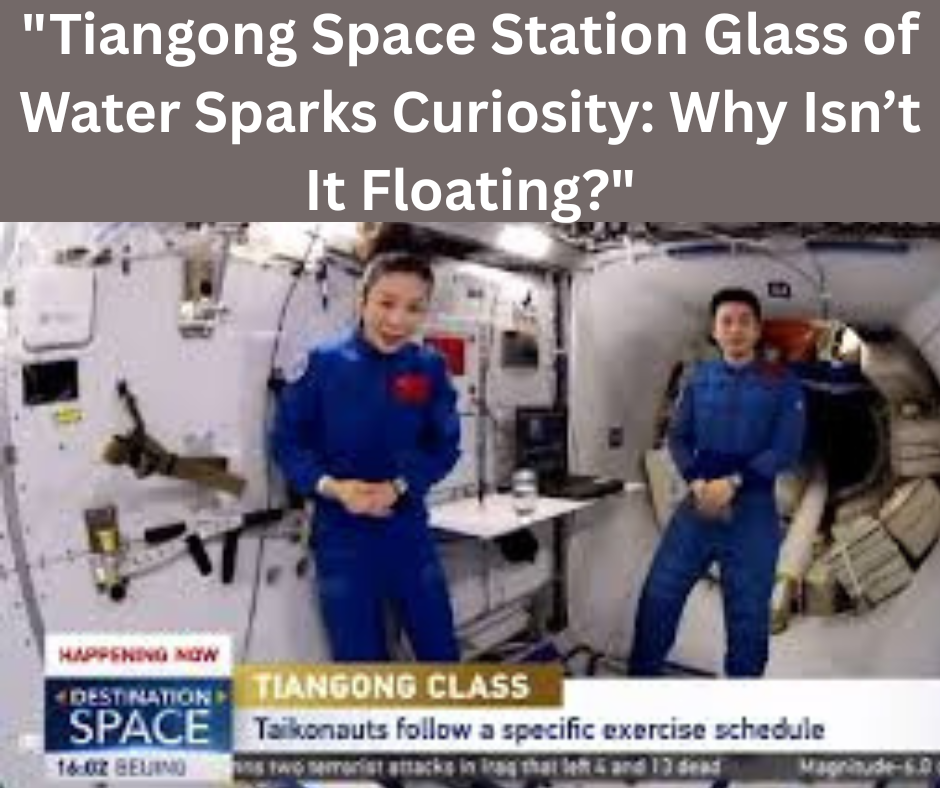Glass of Water Sparks Debate: What’s Really Happening on the Tiangong Space Station?
Why the Tiangong Space Station Video Went Viral
A video from China’s Tiangong Space Station has recently gone viral, showing a seemingly ordinary glass of water placed calmly on a table. However, this seemingly mundane clip has stirred quite a storm online. Viewers across the globe are questioning how water could remain in a glass without floating away in the zero-gravity environment of space. The skepticism has led to conspiracy theories claiming the video might be staged, casting doubt on the authenticity of the scene aboard the Tiangong Space Station.
Conspiracy Theories Surrounding the Tiangong Space Station
The glass of water was first spotted during a live-streamed educational segment by astronauts aboard the Tiangong Space Station. Some social media users questioned the feasibility of such a scene, wondering why the water wasn’t floating around and why the glass itself remained stationary.
Comments like, “Why isn’t the water floating out of the glass?” and “How can you have an open glass of water in zero gravity?” started trending. One user even speculated that the glass might be Velcroed to the table, but that still wouldn’t explain why the water stayed inside it.
Scientific Explanation: Water Behavior in Microgravity
Despite the buzz and suspicion, experts quickly debunked the conspiracy theories. Jordan Bimm, a space historian and researcher at the University of Chicago, explained that water molecules behave differently in microgravity. According to Bimm, “Water molecules like to stick to glass and also to other water molecules more than they like to disperse into air.”
This surface tension creates a cohesive force that allows water to maintain its shape—even in a zero-gravity environment like that of the Tiangong Space Station. So, rather than floating away, the water remains clumped together inside the glass.
Behind the Scenes at the Tiangong Space Station
To further dispel the rumors, China’s space agency released behind-the-scenes footage. The video shows astronaut Wang Yaping pouring water into the glass using a straw and then securing the glass to the table with adhesive strips.
This simple yet effective method ensured the safety of the glass and its contents during the lesson. It also clearly demonstrated the difference in buoyancy and fluid behavior between Earth and space.
Educational Goals of the Tiangong Space Station Crew
The original video was part of a science education session led by the Shenzhou-13 crew aboard the Tiangong Space Station. During the lesson, the astronauts showcased how objects behave in microgravity, including an experiment where a ping-pong ball was suspended in the water.
On Earth, the ball would float to the surface, but in space, it remains suspended—visually illustrating how buoyancy works in a weightless environment. These sessions are aimed at inspiring young minds and bringing science to life in a truly unique way.
Debunking Misinformation About the Tiangong Space Station
The Associated Press also investigated the claims and confirmed the scientific accuracy of the video. According to Molly Silk, a doctoral researcher at the University of Manchester, the Chinese space program has no logical reason to stage such a video. “It is extremely unlikely that the video was faked,” she told AP.
She added that the presence and operations of the Tiangong Space Station have been verified by international space agencies, including NASA. These confirmations further strengthen the legitimacy of China’s ambitious space missions.
Tiangong Space Station: A Symbol of Technological Excellence
China’s space program has made remarkable progress in recent years. The Tiangong Space Station is a significant part of the nation’s long-term goals in space exploration. Along with the success of the Chang’e lunar missions and the recent Chang’e 6 project to return samples from the Moon’s far side, the Tiangong station symbolizes China’s growing influence in space science.
In fact, in May 2025, samples collected by the Chang’e 5 mission were provided to the UK’s Open University for scientific research—an example of international collaboration in space studies.
Why the Tiangong Space Station Video Matters
The controversy over the glass of water may seem trivial at first glance, but it highlights the importance of scientific literacy and critical thinking. The ability of the Tiangong Space Station team to address and debunk such theories through science and transparency shows the integrity of the mission.
It also serves as a reminder of how visual anomalies can lead to misinformation when viewers aren’t fully informed about the physics of space environments.
Conclusion: Tiangong Space Station and the Future of Space Education
The viral video of the glass of water onboard the Tiangong Space Station has unintentionally sparked a global conversation about microgravity, scientific education, and media skepticism. While conspiracy theories briefly clouded the truth, the reality is grounded in science.
With continued educational outreach, real-time demonstrations, and a commitment to transparency, the Tiangong Space Station stands as a beacon of China’s commitment to advancing both space exploration and global scientific understanding.
Read more: Rocket Launch Today
